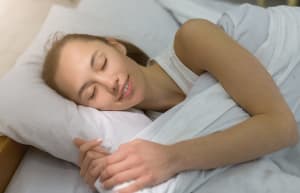Narcolepsy is a neurological sleep disorder that causes extreme daytime drowsiness, despite a sufficient amount of sleep. It is commonly known for the symptom in which patients unconsciously fall asleep in the middle of the day, even while occupied in daily tasks. According to the Cleveland Clinic, narcolepsy affects one in every two thousand American adults.

But there is an important distinction between feeling excess tiredness during your day and getting a diagnosis of a disorder. Learning the causes and symptoms of narcolepsy can help you decide if you should speak to a doctor about a possible checkup.
What Is Narcolepsy?
Narcolepsy is defined as a disorder affecting the brain’s control of the sleep-wake cycle. People with narcolepsy may experience the following symptoms:
- Extreme tiredness during daytime hours: Even when you’ve had a good night’s sleep, you might feel very tired out of the blue. Feelings of overwhelming exhaustion can come with little warning, no matter the activity you are engaged in.
- Falling asleep spontaneously: This follows the extreme tiredness that defines narcolepsy. You can fall asleep any time, anywhere, with little warning. These periods of sleep range from a few minutes to half an hour at a time, and regularly happen many times a day.
- Sudden muscle weakness or paralysis (Cataplexy): Cataplexy can bring other symptoms of narcolepsy. They are usually triggered by strong emotions, both negative and positive. You will be unable to control certain muscles or even your entire body for minutes at a time. It is often misdiagnosed as a seizure disorder. Interestingly, NIH notes that the signs of cataplexy are similar to the conditions the body undergoes during REM (rapid eye movement) sleep.
- Sleep paralysis: Similar to cataplexy, sleep paralysis renders the patient temporarily paralyzed while fully conscious. The difference is that sleep paralysis affects people who are falling asleep, waking up, or in some realm of the “edge of sleep.”
- Hallucinations: Genuine, clear visual hallucinations are common during periods of narcoleptic sleep paralysis. They can be scary, and can sometimes include audible elements as well. Hypnagogic hallucinations happen when someone is beginning to fall asleep. Hypnopompic hallucinations can occur when a person is starting to wake up. Typically, the hallucinations normally last only a few moments.
What Causes Narcolepsy?

Though we don’t know the exact causes of narcolepsy, scientists have linked the disorder to the neuropeptide hypocretin. Orexin helps to regulate our wakefulness and sleep. In patients suffering from narcolepsy with symptoms of cataplexy (known as Type I narcolepsy), there is likely to be extremely low levels of detectable hypocretin.
Hypocretin is especially important in controlling REM sleep. Many of the symptoms of narcolepsy, including cataplexy and sleep paralysis most notably, seem to mimic the actions of our body during REM sleep. Furthermore, the Mayo Clinic explains that narcoleptics seem to enter REM sleep much more quickly than the average sleeper.
There is a greater risk of developing the disorder if anyone in your family already has it. Scientists also link narcolepsy to autoimmune dysfunction and even the H1N1 flu. More research is being conducted to understand what causes Type 2 narcolepsy.
Testing for the disorder
People typically begin to feel the symptoms of narcolepsy when they are young, anywhere from 7 to 25 years old. Usually, the first symptoms to show are excessive daytime sleepiness, which can often be dismissed as simple day-to-day tiredness. However, symptoms will likely advance if left untreated.
If you are concerned that you might be feeling symptoms of narcolepsy, there are several tests that can be done to determine a diagnosis. If the usual in-depth analysis of your medical and sleep histories suggests you might have the disorder, doctors will proceed to administer two tests:
- Polysomnogram (PSG): Also known as a “sleep study,” this overnight test is typically administered in a sleep clinic. Doctors will monitor your brain and muscle activity, eye movements, and breathing during the night. The data they record, especially about the timing and length of your sleep cycles, will help them rule out other sleep disorders as the cause of your symptoms.
- Falling into REM sleep early in the night is a good indicator that you may be suffering from Type 1 narcolepsy (narcolepsy with cataplexy). Type 1 includes extreme tiredness during the day, cataplexy, and in extreme cases sleep paralysis, and even hallucinations.
- Multiple Sleep Latency Test (MSLT): Immediately following a PSG, patients are asked to take a series of daytime naps under direct doctor supervision. The speed at which they fall asleep and enter the REM stage of the sleep cycle can be used to make a diagnosis of narcolepsy.
Pending the results of these two tests, and especially if patients exhibit symptoms of cataplexy, doctors may follow up with a spinal tap test. This helps to determine the amount of hypocretin in the patient’s spinal fluid. Low levels of the neuropeptide are a strong indicator of Type 2 narcolepsy.
Treatments for Narcolepsy
Narcolepsy is a disorder for which there is no cure, though symptoms seem to decline over time. Managing the symptoms of narcolepsy is a lifelong challenge that requires vital changes to lifestyle, and significant help from family or friends.
The NIH lists a few medications which have shown promise in treating the symptoms of narcolepsy:
- Modafinil: A low-level nervous system stimulant that helps improve alertness and reduce drowsiness.
- Amphetamines and other stimulants: Stronger than modafinil, these can be effective at combating sleepiness during the day. Though it is important to monitor patients using these drugs for significant side effects, ranging from irritability to heart conditions.
- Some types of antidepressants: These may be effective in combating cataplexy, and pose fewer risks than amphetamines.
- Sodium oxybate (Xyrem®): This extremely strong sedative is prescribed to treat cataplexy and daytime drowsiness.

Additionally, the following lifestyle changes can be extremely effective for people with narcolepsy on a day-to-day basis:
- Take regular short naps throughout the day
- Avoid caffeine and alcohol before bed
- Keep a regular sleep cycle and maintain good sleep hygiene
- Don’t eat heavy meals right before bed
- Avoid smoking, especially in the evenings

 Scientists have linked the most vivid, bizarre and memorable types of dreams to REM (rapid eye movement) phase of the sleep cycle. This is likely related to the fact that REM sleep brings the
Scientists have linked the most vivid, bizarre and memorable types of dreams to REM (rapid eye movement) phase of the sleep cycle. This is likely related to the fact that REM sleep brings the 



 From carefree kids and overworked parents to even the
From carefree kids and overworked parents to even the  Although there probably isn’t one “perfect” nap, there are certainly
Although there probably isn’t one “perfect” nap, there are certainly 

